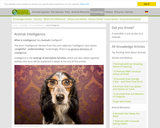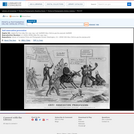
Are animals intelligent? What is intelligence? How can you tell, whether animals are intelligent?
- Subject:
- Education
- Elementary Education
- Life Science
- Zoology
- Material Type:
- Primary Source
- Date Added:
- 09/10/2018

Are animals intelligent? What is intelligence? How can you tell, whether animals are intelligent?

A swipe at President Van Buren's independent treasury system and his continuation of the monetary policies of predecessor Andrew Jackson. The artist, clearly in sympathy with the Whigs, links corruption in the federal customs and postal systems with the sub-treasury system, whereby federal funds were to be retained by the revenue-collecting agencies and other designated repositories, instead of private banks. The artist forecasts Van Buren's defeat in the 1840 elections. Van Buren, hypnotized by Jackson, is on a couch with a royal crown and scepter on one side and sword and purse on the other. Jackson, his toes touching Van Buren's, sits in a chair to the left with his white plug hat and cane next to him. On the right Treasury Secretary Levi Woodbury (arms crossed), Postmaster General Amos Kendall, and "Globe" editor Francis Preston Blair (far right) observe. Jackson: "Are you asleep? Do you hear me? Tell me what you see?" Van Buren: "I am asleep. I hear nobody but you.--I see a great pole, and a crowd of people. They are cheering an elderly man; whom they hail as President of the United States. On their banners are inscribed Whig Principles!!! I see a little man tumbling down a precipice; on his back is a mill stone inscribed Sub-treasury! oh! lord, oh! lord! Why it is myself!" Woodbury: "Ask him Dr. Jackson, if he sees any thing of "Price" or Swartwout?" (See "Price Current" and "Sub Treasurers Meeting in England," nos. 1838-21 and -20.) Kendall: "Ask him at what rate the Express Mail for North is going now?" Blair: "This will make a good paragraph for the Globe!"|Entered . . . 1839 by John Childs.|New York. Published & sold by J. Childs, Lithographer. 119, Fulton-Street.|Signed with monogram: EWC (Edward Williams Clay).|The Library's impression of the print was deposited for copyright on February 22, 1839.|Title appears as it is written on the item.|Davison, no. 122.|Weitenkampf, p. 58.|Forms part of: American cartoon print filing series (Library of Congress)|Published in: American political prints, 1766-1876 / Bernard F. Reilly. Boston : G.K. Hall, 1991, entry 1839-2.

Jewish Anne Frank hid in 1942 from the Nazis during the occupation of the Netherlands. Two years later she was discovered. In 1945 she died in the Bergen-Belsen concentration camp.
These lessons explain more about Anne Frank's life and the historical context around Anne Frank's diary.

How did Anne Frank's diary become one of the most read, most important and most inspiring books in the world? Learn more by exploring the lessons in this unit.

Roosevelt, Theodore. “Address of Vice President Roosevelt, Minnesota State Fair, Minneapolis, Sept. 2nd, 1901.” The Minneapolis Journal. [volume] (Minneapolis, Minn.), 02 Sept. 1901. Chronicling America: Historic American Newspapers. Lib. of Congress. <https://chroniclingamerica.loc.gov/lccn/sn83045366/1901-09-02/ed-1/seq-16/> Accessed Oct. 20, 2021. This work is in the Public Domain.

Poster showing a soldier blowing a bugle. Poster no. 21. W. 8.790/174. 25M. 12/14. Title from item.

Poster showing a Marine carving a notch in the stock of his rifle. Title from item.

In 1943, Ansel Adams (1902-1984), America's best-known photographer, documented the Manzanar War Relocation Center in California and the Japanese Americans interned there during World War II. The collection presents for the first time side-by-side digital scans of both Adams's 242 original negatives and his 209 photographic prints, allowing viewers to see his darkroom technique and in particular how he cropped his prints. Adams's Manzanar work is a departure from his signature style of landscape photography. Although a majority of the photographs are portraits, the images also include views of daily life, agricultural scenes, and sports and leisure activities.

Poster showing the flags of Great Britain, France, Russia, and Belgium. Poster no. 64A. Title from item.

Poster showing a civilian rising from his desk and putting on his coat, as a man in uniform opens the office door to reveal a battlefield. 130 Bunhill Row EC or Winchester House, Old Broad St. EC. Title from item.

American Red Cross campaign poster showing a winter scene with snow covered house and trees. Issued(?) by: Committee on Public Information, Division of Pictorial Publicity. Copyright 1918 by American Red Cross.

A cynical look at the opposition to American annexation of Texas during the 1844 campaign. At the head of a motley procession is Whig candidate and professed anti-annexationist Henry Clay, riding a raccoon (which looks more like a fox). He is followed by three groups of men. The first (right) are the "Hartford Convention Blue-Lights," who shout, "God save the King!" and "Millions for Tribute! not a cent for defence Go it Strong!" Next (center) is a line of "Sunday Mail Petitioners," led by Clay's strongly religious running-mate Theodore Frelinghuysen, riding a donkey and dressed in clerical robes. They represent the proponents of eliminating postal service on Sundays in the United States, whose campaign was criticized by many as a threat to the separation of church and state. One of them remarks, "I go for the Good old times! wholesome, Fine and Imprisonment!" Prominent antislavery advocate William Lloyd Garrison leads the third group. He displays the banner of "Non Resistance, No Government No Laws--Except the 15 Gallon Law!" His folllowers are the "Abolition Martyrs" (far left), who have been tarred-and-feathered for their activism.|Entered . . . 1844 by J. Baillie.|Lith. & pubd. by James Baillie 118 Nassau St. N.Y.|Signed: H. Bucholzer.|The Library's impression was deposited for copyright on August 26, 1844.|Title appears as it is written on the item.|Weitenkampf, p. 77.|Forms part of: American cartoon print filing series (Library of Congress)|Published in: American political prints, 1766-1876 / Bernard F. Reilly. Boston : G.K. Hall, 1991, entry 1844-43.
![Antimasonic Convention In Valdimor [on The] Corner-Stone March](https://img.oercommons.org/160x134/oercommons/media/upload/materials/screenshots/materials-course-76553.png)
An illustrated sheet music cover for a march dedicated to the Masons. According to the text the march was performed "at the Ceremony of laying the Corner Stone of the Masonic Temple, Boston." The illustration parodies the national convention of the Antimasonic party, held in September 1831 in Baltimore ("Valdimor"). The convention nominated William Wirt for President and Amos Ellmaker for Vice President. The attendees are pictured as asses, geese, goats, and other animals gathered at a table presided over by a donkey wearing spectacles (center). A horse at left says, "Mr. President I should like to know what course we are to pursue with regard to the Presidency. I hope no candidate will be entered who is not a "full blooded" Antimason. rather than vote for any other I will "run" for the office myself." A cat in the background says, "No secret societies." A pig at right: "...I agree with my friend opposite. To save my own "Bacon" I would not vote for any man who would not go the "Whole Hog" for Antimasonry. A dog: "...I'm not used to many words. I never spin out a long yarn without getting into a "snarl." I've only to say, that since I have em"barked" in this business I am resolved to go the hull figure." On the wall in the background a clock reads five minutes to midnight.|Boston. Published by C. Bradlee 164 Washington St.|Drawn by David Claypool Johnston.|Entered . . . 1832 by C. Bradlee.|The print appears to have been drawn by David Claypool Johnston. Malcolm Johnson records a sketch for the illustration in the collection of the American Antiquarian Society. D. C. Johnston's "Much Ado about Nothing" (see 1832-3), published in Boston slightly later, is akin in style, lettering, and in the nature of the scene. Both prints include the motif of a clock on the background wall.|Title appears as it is written on the item.|Johnson, no. 141.|Weitenkampf, p. 27.|Published in: American political prints, 1766-1876 / Bernard F. Reilly. Boston : G.K. Hall, 1991, entry 1832-1.

The Antiquities of Wisconsin, Increase A. Lapham's most important published work, includes 92 pages of text, illustrated with 61 wood engravings, and 55 lithographed plates and was the result of his research into the Indian effigy mounds found on Wisconsin's Landscape.

The ceremony of placing wreath on the grave of Atatürk, the father of the Turks.

These 4 primary sources (journal-type entry, letter, image, excerpt from law) give a perspective of apartheid in South Africa.

NASA presents this gallery of images from the Apollo 11 mission to the moon in 1969.

The print is a fragment of a larger lithograph entitled "Invasion of Cuba," composed of two panels, applauding American "filibustering" expeditions to liberate Cuba from Spain. (See also "The Great Naval Blockade of Round Island" and "Genl Lopez the Cuban Patriot Getting His Cash," nos. 1849-5 and 1850-10.) "Invasion of Cuba" evidently appeared in the wake of Lopez's second failed invasion of Cuba in August 1851. The left panel, "The Expedition," expresses sympathy with American intervention there in defiance of Great Britain. Our panel criticizes the Fillmore administration's conciliatory attitude toward Cuba, and alignment of the island's Spanish rule with the Catholic Church and other conservative powers in Europe. Spanish governor Jose Gutierez de la Concha sits on a throne in the center of a crowded scene, his left foot on the face of the recumbent female figure of Cuba, as he decorates American consul A. F. Owen, who kneels at left. In the right foreground American Secretary of State Daniel Webster holds a "Secret Treaty with Spain" in one hand and behind his back clasps hands with Britain, represented by a lion in sailor's costume. Nearby stands a fox in uniform, probably representing France. To the right of the throne stand various prelates, bishops, and the pope, along with several beasts wearing crowns. On the left of the throne are ministers with star-shaped heads, in a state of agitation. In the left foreground Brother Jonathan, smoking a cigar and waving a saber, carries off a Cuban flag. Above Gutierez's throne are several smaller scenes of Spanish atrocities. On the left is the execution by a Cuban firing squad of American volunteers under W. H. Crittenden in Havana, August 16, 1851. The captive Americans are bound and kneeling. In the center, expedition commander Narciso Lopez is garroted by a black man, as he sits in a chair decorated with a small cross (an anti-Catholic reference). The scene on the right shows two ships, one American and one Cuban, and has the date August 13. It may represent the capture of Crittenden's retreating forces on the high seas. Below the print is the caustic commentary: "Our Consul at Havana decorated by Don Quixote with the Order of the Golden Fleeze for his Neutrality in the Cuba Question under the Applause of the Absolute Powers! The Stars in Consternation. Jonathan runs off swearing: 'Cuba must be smoked' anyhow!"|Signed with monogram: AW.|Title appears as it is written on the item.|Murrell, p. 188-189 (reproduces the complete print).|Weitenkampf, p. 104.|Forms part of: American cartoon print filing series (Library of Congress)|Published in: American political prints, 1766-1876 / Bernard F. Reilly. Boston : G.K. Hall, 1991, entry 1851-4.

Title from item. Poster is text only, with lengthy message encouraging enlistment and support of the war effort.

Poster showing ribbons linking Wedgewood-style plaques depicting soldiers. Title from item. Poster no. 5. W.6398, 20M - 7/15.